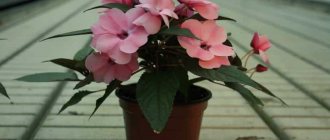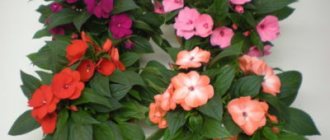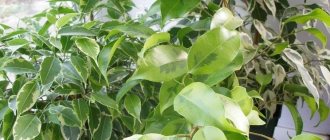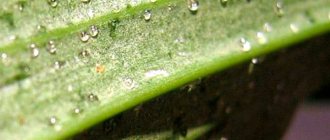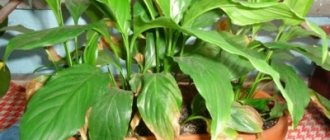There is probably not a single gardener who does not like the delicate, handsome balsam.
A lush bush with rich green foliage is amazingly beautiful in itself, but when delicate inflorescences begin to open on it every day, and this continues for quite a long time, you simply cannot take your eyes off the flower. But it’s not for nothing that they believe that balsam has a hot-tempered character, to put it mildly. I almost forgot to water the plant, and now the crown has disintegrated, the leaves have drooped like rags, or even the leaves have completely fallen. Why does this happen and how not to lose your pet? There may be several reasons why the leaves of a wet Roly will fall off:
- change in conditions of detention;
- disease;
- pest damage.
Common balsam diseases and their treatment
One of the main signs indicating that “Vanka wet” requires the help of a grower is a change in the appearance of the plant. Strange spots, leaf drop, discoloration, or wilting are the most common signs of a problem. In most cases, the cause of the development of diseases or damage to balsam by pests is incorrect care.
If the conditions of maintenance are violated, the immunity of plants, which ensures their resistance to parasites and pathogens, begins to rapidly decline. Some diseases are destructive to balsams. Given this fact, it is important to take all necessary measures in time, as soon as you notice that the flower has acquired a sickly appearance.
Bacteriosis
The fact that the plant has become a victim of a dangerous disease - bacteriosis, is indicated by the formation of gray-brown spots on its leaves. As the disease progresses, the lesions become black-brown in color. Among the main causes of bacteriosis, flower growers cite excess moisture in the soil. In addition, balsam can be infected with bacteriosis pathogens through infected (poor-quality) soil or untreated tools. This disease is very dangerous, since most often the plant affected by it dies quite quickly.
In most cases, diseased flowers must be destroyed. However, you can try to compete for your green pet in the following way:
- remove all affected parts of the plant;
- thoroughly spray the bush and soil in the pot with a solution of copper oxychloride (4 grams of substance per 10 liters of water);
- repeat treatment after 2 weeks.
Important! During treatment, the plant must be isolated from healthy flowers. Considering that this disease is extremely contagious, the risk of its spread throughout the entire green collection is very high.
Powdery mildew
The fact that the plant has suffered from powdery mildew is indicated by specific whitish spots that form on the leaves. If you do not start treating the disease in a timely manner, very soon the affected leaves will wither and fall off. The main causes of this disease are disturbances in temperature and humidity conditions, incorrect watering and lack of lighting. The complex for treating powdery mildew includes the following measures:
- removal of affected parts;
- treating the bush with a soap-soda solution (1 tablespoon of soda ash, 2 tablespoons of soap, 5 liters of warm water); the plant is treated using a sprayer for indoor flowers;
- after 1.5–2 weeks the procedure is repeated.
Mosaic
One of the most dangerous diseases that leads to the death of balsams is mosaic. Specific symptoms of this disease are the formation of yellowish spots and deformation of the foliage. As the disease progresses, the tissue of the affected leaf blades undergoes necrosis, as a result of which the plant gradually turns yellow and eventually dries out completely. The main carriers of the causative agents of this disease are thrips - tiny parasites that live in the soil.
Since there are currently no effective treatments for this disease, diseased plants are usually destroyed.
Rot
Failure to follow plant care recommendations often causes the development of an insidious fungal disease - gray rot. With this problem, dirty brown spots begin to form on the foliage of affected balsams. Beginning flower growers often encounter the development of rot on balsams as a result of watering with cold water, as well as due to too low air temperature in the room. To save the plant, you must adhere to the following steps:
- remove all infected parts of it - leaves and stems covered with spots, in this case they are cut off with a sharp disinfected blade, after which they are destroyed;
- after the procedure, the diseased bush is carefully treated with fungicidal preparations (“Fundazol”);
- To make the treatment more effective, you can spray the plants with products prepared according to folk recipes, for example, an infusion of dry garlic or onion peels.
Read also: Garden plant with large leaves
Pests
Impatiens are quite resistant to pest attacks, but flower growers often have to face this problem. Some parasites can be detected with the naked eye, others with a magnifying glass. The activity of others can be indicated by corresponding traces of vital activity - fragments of cobwebs, spots and dots on leaves, buds and shoots.
Spider mites
Very often, weak balsams become victims of spider mites. The fact that the plant has suffered as a result of the activity of these pests is indicated by the formation of a whitish coating on the leaves that has a fibrous structure. This plaque is a waste product of mites that feed on the juices of the flower. In most cases, these parasites enter pots with indoor plants from the external environment.
They can be brought into the house on clothes and shoes. And also the source of the spread of pests can be contaminated soil, purchased from a dubious store or prepared with your own hands from untreated ingredients. To destroy ticks, chemical agents are used - “Aktellik”, “Fitoverm”.
The process of treating plants will go much faster if the affected bushes are additionally sprayed with soapy water.
These tiny pests often plague indoor flower lovers. The fact that the green pet has suffered from the activity of aphids is indicated by yellowing and deformation of its leaves, buds and shoots.
In case of excessive infestation of plants by aphids, through a magnifying glass you can examine not only traces of their vital activity (accumulations of a sticky substance), but also colonies of the parasites themselves, which usually collect on the underside of the leaves. Strong chemicals - Fitoverm, Decis - . Actellik has proven itself well in the fight against aphids
Additionally, it is recommended to treat affected plants with a soap solution or a solution of tobacco dust.
Whitefly
One of the most difficult parasites to kill is the whitefly. This is a tiny white butterfly that causes serious damage not only to flowers growing at home, but also to outdoor plants. To destroy this pest, pesticides are used - “Karbofos”, “Dichlorvos”. “Fufanon” and “Aktellik” also help to effectively combat the problem
Why do the buds fall off?
Often, beginning flower growers are faced with situations when the “Vanka wet” flower begins to shed its buds. The main reasons for this phenomenon include violations of temperature and humidity conditions, excess nitrogen in the soil mixture and potassium deficiency. Another reason that can cause buds to fall off is a draft. Impatiens are very sensitive to drafts and cold snaps, which are stress factors for them. It is also necessary to check the condition of the soil mixture in the pot. It should not be over-moistened.
Despite the fact that this flower loves regular watering, excess moisture in the soil can cause its roots to die and the buds to fall off.
Reproduction
Reproduction of wet roly-poly is possible at any time of the year. Cuttings are made below the nodes, removing the lower leaves and the weak top.
Vanya propagates by cuttings. For planting young seedlings, the substrate must be light enough. In order for the plant to take root faster, the bowls are placed in a dark place for a couple of weeks.
Planting is carried out when their length is 5-6 cm in soil fertilized with peat and sand. It is possible to place several roots in one pot at once, so the flowering of the bush will be more luxuriant.
Vanka can be propagated by seeds in the spring by planting 2-3 seeds in a pot, pre-treated with a weak solution of potassium permanganate (1%).
Why do the leaves curl?
There may be several reasons.
- Curling and deformation of leaves often indicate that the flower lacks moisture and light. These indoor plants do not tolerate lack of watering and darkness.
- Very dry air in the room can also cause leaves to curl. In this case, spraying allows you to restore their previous appearance.
- Direct sunlight can negatively affect the condition of leaves. To protect the plant from sunburn, it needs to be provided with soft but sufficient lighting. In hot and sunny weather, it is recommended to shade balsams.
Important! Having noticed that the plant is dying, and the shape of its leaves has changed greatly, it is important to carefully examine the flower for the presence of pests or traces of disease. It is best to inspect a problem plant using a magnifying glass.
Wet Vanka (Balzamin) - how to care for it at home?
Balsam, or Vanya Wet (lat. Balsamina) is a popular indoor plant that can bloom profusely most of the year with proper care. The tropics and subtropics of Asia and Africa are considered the birthplace of the culture. The plant belongs to the Balsam , the genus Impatiens (Impatientaceae), which has about 500 species .
Balsam first came to European countries at the end of the 16th century, and then spread throughout the world. hybrid varieties were obtained , characterized by compactness and high decorativeness. This contributed to the growing popularity of balsam as a houseplant. This flower received the popular name Vanka Wet for its ability to secrete a sugary liquid from its leaves, which occurs after watering, as well as at high air humidity.
Why does balsam wither and dry out?
Withering and drying of the plant is a common result of improper care. At the same time, both deficiency and excess moisture in the air and soil mixture can cause such a problem. To restore the appearance of a plant damaged by drought, it is enough to resume the previous watering regime. But the soil should not be allowed to become waterlogged, so as not to destroy the roots.
Read also: Peat-based substrate
Another reason for balsam wilting is often a lack of nutrients. In this case, you can give strength to the plant by feeding it with humic fertilizers. Flower growers also claim that in some cases iodine will help eliminate the painful appearance of a flower. To do this, use a solution of 2 drops of iodine and 2 liters of water no more than once a month. This solution (about 50 ml per plant) is carefully poured onto the soil near the walls of the pot so as not to burn the root system.
Questions - answers
The stems became bare and became long and thin, why?
The plant may be lacking light, pot space, or nutrients. If the flower was planted a long time ago, then it’s time to replant it. Cut off several young shoots and root them in a new pot.
The stems darkened, twisted, and the leaves rotted why?
This happens when a wet roly moss is placed in a cold and damp place or with frequent watering. You need to place the pot in a warmer and drier place, and drain the soil. If it doesn’t help, there is only one thing left - a transplant.
Why do the leaves fall?
Leaves may fall off due to heat, dry air and soil. Do not place the plant on a windowsill next to a hot radiator in winter, or in the sun in summer. Find some shade for the flower or place it on the floor in the heat, spraying it periodically.
This is the second year that it’s been raining, but there’s still no flowering, why?
The main reason is lack of light. Perhaps there are few minerals or, on the contrary, there is an excess of them. If there is a deficiency, feed the soil with nitrogen fertilizer. Place the pot closer to the sun or, conversely, in a cool place, depending on the situation. Feed the plant. If it doesn't help, replant in a week.
Vanka wet has withered away from fungus, what should I do?
The development of fungus is possible with frequent watering, or placing the flower in the cold. There is only one solution to the problem - replant the plant. Remove the plant from the pot and shake the roots off the ground.
If the soil is acidic, first install drainage in the new pot. Move the plant, compacting the root moderately. Water and place in a warm and slightly humid place.
Vanya wet - a luxurious flower with many colorful flowers-lights, will be able to delight others almost throughout the year. Take care of the proper cultivation of the plant; it will thank you with luxurious bouquets and constant flowering.
Source
How to save a frozen plant?
Drafts and low temperatures are detrimental to delicate balsams. If they caused the plant to die, you can try to correct the situation. To do this, all frostbitten parts of the flower are removed and trimmed down to living and healthy tissue, after which watering is temporarily reduced. While the affected balsam is sick, it is provided with extremely gentle conditions. In some cases, gardeners save the plant in a radical way, dividing it into cuttings.
Frostbitten leaves on cuttings, as in the previous case, are removed and trimmed to undamaged tissue.
Prevention and proper care
In order for balsams to delight their owner with lush green foliage and regular flowering, they need to be provided with comfortable living conditions. Thus, caring for balsam at home involves fulfilling such important conditions as:
- sufficient diffused lighting throughout the day;
- regular abundant watering (in summer), eliminating waterlogging of the soil;
- high-quality soil mixture and the presence of a drainage layer in the pot;
- moderate watering in winter (about 1 time every 2 weeks);
- maintaining the air temperature at a level of at least +15°C.
In order for the plant to feel normal and be able to fully develop and bloom, it should be provided with regular feeding . The recommended frequency of fertilizing is about 1 time per month (from spring to autumn). With the onset of winter, they stop feeding the plants. Impatiens do not have any special requirements for air humidity if the room temperature does not exceed +22°C.
However, as temperatures rise, plants begin to need moist air . In this case, flower growers recommend using household humidifiers and regularly spraying the plant.
It is very important to protect balsams from drafts and cold weather. During the flowering period, when plants become most vulnerable, drafts and low temperatures can cause flowers and buds to fall off. For all their relative unpretentiousness, balsams do not like changing places. For this reason, they try to grow them without resorting to frequent movements from one place to another.
These plants feel very comfortable on window sills in the western and eastern parts of the house.
For tips on caring for balsam at home, watch the video below.
If all else fails
Impatiens is a whimsical plant, so you shouldn’t neglect its condition by postponing “reanimation” until the last moment.
If the plant has turned yellow and is dropping all or almost all of its leaves and none of the measures suggested above helped, you need to:
- Remove all dead areas from it (including rotten or dried roots).
- Spray the above-ground part with a growth stimulator and place the pot in a greenhouse, ensuring regular ventilation.
If these actions do not give positive results, the plant can be safely thrown away. All gardeners learn from mistakes and, having figured out the intricacies of growing “Vanka wet” using this sad example, you will certainly cope with its newly acquired relative.



